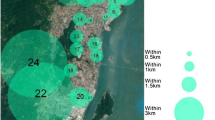Abstract
The paper presents the results of assessing the comfort potential and development prospects of urbanized geosystems in the steppe zone of Russia based on the developed geographic information index. It is necessary to reduce the anthropogenic load on the environment to ensure a comfortable and sustainable living environment in cities. Urban green areas are an essential part of the well-being and health of citizens. The index was calculated based on indicators of the total area of technical geosystems of the territory, consisting of the sum of the areas of individual functional zones and the ratio of existing and planned natural and anthropogenic components to territories suitable for expanding green zones. We constructed cartographic models reflecting the differentiation of the territory of urbanized geosystems. Also, we identified areas with negative index values, where it is impossible (or minimally possible) to “green” the territory due to the high density of existing anthropogenic geosystems. Low positive indexes (from 0 to 0.5) refer to urban landscapes that are relatively suitable for planting trees and shrubs. The closer the positive value of the indicator is to 1, the higher the potential for recreational zones development, and the lower the existing anthropogenic load of a set of technogenic subsystems. Calculation of index values for the studied cities showed significant differences in the planning structure, spatial and temporal development of infrastructure, and the relief of the Volgograd and Orenburg urban landscapes.
Access this chapter
Tax calculation will be finalised at checkout
Purchases are for personal use only
Similar content being viewed by others
References
Bush J, Doyon A (2019) Building urban resilience with nature-based solutions: How can urban planning contribute? Cities 95:102483. https://doi.org/10.1016/j.cities.2019.102483
Eprintsev SA (2013) Geoecological aspects of environmental quality of urban territories. Bull Tomsk State Univ 18(2):596–601
Eprintsev SA (2014) Assessment of ecological comfort of population of urban territories. Bull Tomsk State Univ 19(5):1410–1412
Government of the Russian Federation (2019) Order of the Government of the Russian Federation On approval of the methodology for determining the urban environment quality index (March 23, 2019 No. 510-r). Moscow, Russia
Khomich VS, Kakareka SV, Kukharchik TI, Kravchuk LA, Struk MI, Kadatskaya VO, Sanets EV (2013) The urban environment: geoecological aspects. Belaruskaya Navuka, Minsk, Belarus
Kohonen T (2013) Essentials of the self-organizing map. Neural Netw 37:52–65
Kostin AM, Belov SA, Malev IV (2016) Peculiar features of influence of the modern ecological state of the city of Chelyabinsk on economic and architectural indexes of the territory. In: Rodionov AA (ed) Proceedings of ICIEP-2016: international conference on industrial engineering. Elsevier Ltd., Chelyabinsk, Russia, pp 2025–2030. https://doi.org/10.1016/j.proeng.2016.07.287
Ministry of Natural Resources and Environment of the Russian Federation (2003) Guidelines for assessing the quality of the environment according to the condition of living things (assessment of the stability of the development of living organisms by the level of asymmetry of morphological structures) (October 16, 2003 No. 460-r). Moscow, Russia
Tikunov VS, Chereshnya OYu (2017) Pollution index and environmental stress index in the regions of the Russian Federation. Theoretical Appl Ecol 3:34–38
Vinogradov PM, Kurolap SA, Klepikov OV (2014) Geoinformation support for medical and environmental monitoring of the urban environment (on the example of the city of Voronezh). Bull Voronezh State Univ Ser Geogr Geoecol 4:39–48
Yermolaev OP, Selivanov RN (2014) The use of automated geomorphological clustering for purposes of urban planning (the example of the city of Kazan). World Appl Sci J 30(11):1648–1655. https://doi.org/10.5829/idosi.wasj.2014.30.11.14229
Acknowledgements
The study was carried out as part of the research plan of IS UB RAS No. AAAA-A17-117012610022-5.
Author information
Authors and Affiliations
Corresponding author
Editor information
Editors and Affiliations
Rights and permissions
Copyright information
© 2023 The Author(s), under exclusive license to Springer Nature Switzerland AG
About this chapter
Cite this chapter
Dubrovskaya, S.A., Ryakhov, R.V., Pavleychik, V.M. (2023). The Comfort Potential and Development Prospects of Cities in the Steppe Zone of Russia Using the Index Method. In: Maximova, S.G., Raikin, R.I., Chibilev, A.A., Silantyeva, M.M. (eds) Advances in Natural, Human-Made, and Coupled Human-Natural Systems Research. Lecture Notes in Networks and Systems, vol 250. Springer, Cham. https://doi.org/10.1007/978-3-030-78083-8_4
Download citation
DOI: https://doi.org/10.1007/978-3-030-78083-8_4
Published:
Publisher Name: Springer, Cham
Print ISBN: 978-3-030-78082-1
Online ISBN: 978-3-030-78083-8
eBook Packages: Intelligent Technologies and RoboticsIntelligent Technologies and Robotics (R0)




